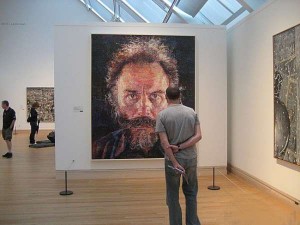Painting Robot
I was walking along and came across Lucas. I was stuck in my tracks, I could not leave.
On one front it’s a striking portrait that’s closer to life than a photograph. Coming close reveals it’s brush strokes, moving away shows the subject’s presence. You can step back and forth between the details of an illusion and a reality.
And the painting is very large. So that amplifies the experience because you have to take so many steps.
But on another front there was something more profound happening. I was seeing color that I had not seen before. This was both disturbing and tickley at the same time.
The Impossible
I was seeing an unreal glow of color. Like a color from the haze of a dream. I can’t describe it however I’m inclined to report it as proximity to blue and black. As an enthusiast of color, color theory, techniques and art I stayed to reflect.
I believe this color experience comes from the artists unique pixelation and pointillism techniques. His color has additive and subtractive elements increasing the gamut of the work beyond any RGB monitor or CMYK printing process. Beyond what we see in textiles and nature. I’m sure there’s a butterfly somewhere in a forest that gives this blue-black I describe. But for the most part this color experience is not part of the everyday because you can’t photograph or print it with current technology.
So don’t look at the pictures I’ve provided. You have to see this in person.
 Closer examination reveals that he has taken a pencil and divided the canvas into a centimeter square grid. Each cell received a collection of splotches (like a little picture) of red, green, blue, green, orange, yellow, black and white. Imagine RGBCMYOWK. The result is so vivid it is impossible to do with conventional painting.
Closer examination reveals that he has taken a pencil and divided the canvas into a centimeter square grid. Each cell received a collection of splotches (like a little picture) of red, green, blue, green, orange, yellow, black and white. Imagine RGBCMYOWK. The result is so vivid it is impossible to do with conventional painting.
The piece is by Chuck Close and is in the Metropolitan Museum of Art in New York City.
Inspiration
I had dreamed of making a machine that can paint and Lucas made me realize how well it could work. The project could be about color experience.
A painting robot is a tough egg to swallow because it seems to trivialize the work. But it doesn’t in fact it can open new doors. Color exploration can be taken to a new level by removing the human labor content from the delivery of paint. If you still can’t swallow it, imagine a new process of printing for photography. That’s not how I think of it but it’s a good thought experiment to get past dogma of disinterest of robotics and automation in art (deploy at dinner parties as necessary).
I’ve been working on this for some time and it proves to be tricky. I made a series of drawing robots which helped me understand the challenges better.
I’ve thought of ways to deliver paint. Brushing, stamping, squirting and more. Either way for long runs paint will run out or dry. There needs to be a continuous paint delivery system. I’ve started to work on this. Turns out it’s not trivial.
I looked at making a brush or stamping system that was continually fed by a collection of pistons that could drive the paint forward. If a lead screw were used to drive the pistons then the paint delivery could be very precise. I started to draw this up but I think it’s way to complicated.
I’ve done some work on sourcing the parts and thought about control but this thing is complex. I’ve kept it in the background of my mind for some time awaiting the answer to come forward.
I decided to try a brush dipping system and use a wall mounted gantry to dip into the paint and then deliver to the canvas. I had originally thrown this idea out since the paint would dry up during long runs. But it dawned on me that the paint could be covered and the cover could open only when the machine is dipping. I think this will work. And little doors on the paint bottles will give the machine charisma. I’ve ordered linear bearings and drive components for a 30″ x 30″ machine. I think I want to try this with ink. Perhaps some India ink or acrylic ink. Acrylic will be fast drying and colorful. That may come forward first. This will be interesting.
The following experiment proves a couple of the concepts. Don’t be fooled by the apparent clumsy appearance. The brush pressure has a pressure granularity of about 50 steps and the machine precision is nearly 1000th of an inch. It is just running a simple test script so it does not appear to have any finesse.







Actually that machine is surplus now.. I’m working on another..
Hey Darcy,
Enjoyed watching the video of the painting robot! Great stuff! It did the job and more.
Sanjay